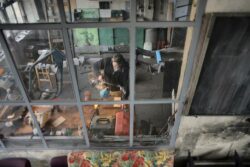Cell Tower Climbers Risk Life and Limb
Cell tower climbers operate in a high-risk environment, regularly exposed to significant dangers. This article critically examines the perils faced by these professionals, the role of workers' compensation, potential for third-party lawsuits, and the necessity of legal expertise. Additionally, it explores preventive strategies, the impact of proper training, and available resources. This comprehensive analysis aims to highlight the often underappreciated challenges in this industry and the support structures in place.

Key Takeaways
- Falling from a cell tower is a significant risk faced by cell tower climbers.
- Cell tower technicians can be exposed to hazards such as electrocution and falling objects.
- Workers compensation benefits should cover injuries sustained by cell tower technicians.
- In some cases, third-party lawsuits can provide additional compensation beyond workers compensation benefits.
Understanding the Job of Cell Tower Climbers
In understanding the job of cell tower climbers, it's crucial to acknowledge the significant risks they encounter, such as potential falls, electrocution, and falling objects, which necessitate comprehensive training, rigorous safety measures, and appropriate workers' compensation coverage. The primary job responsibilities of cell tower technicians include installation, maintenance, and repair of cellular equipment, often at daunting heights. Safety measures for cell tower climbers involve use of protective gear, adherence to safety protocols, and regular equipment inspections to mitigate risks. Despite these precautions, accidents occur, emphasizing the need for adequate insurance coverage. The high-risk nature of this profession underscores the importance of stringent safety practices, continual training, and robust workers' compensation policies.
Identifying the Risks Associated With Cell Tower Climbing
The identification of risks associated with cell tower climbing is a critical step in implementing effective safety measures and protocols to protect workers in this high-risk industry. Understanding the dangers of working at great heights, from falling objects to electrocution and even tower collapse, is paramount. The importance of safety equipment and protocols in cell tower climbing accidents cannot be overstated. Harnesses, ropes, and other gear are essential, yet training in their use is equally crucial. Weather conditions and equipment failure further compound these risks. Ultimately, mitigating the dangers cell tower technicians face requires a comprehensive approach: rigorous adherence to safety protocols, continued education on potential hazards, and a culture of safety that prioritizes the well-being of these workers.
The Role of Workers’ Compensation in Cell Tower Climbing Accidents
Cell tower climbers' reliance on workers' compensation in the aftermath of job-related accidents underscores the importance of this insurance coverage in the telecom industry. The inherent risks associated with this profession make Workers' compensation benefits for cell tower accidents vital. This insurance provides a safety net, covering medical expenses, lost wages, and rehabilitation costs. However, the complexity of the telecom milieu can lead to scenarios where Workers' compensation insurance coverage for climbers may be contested, highlighting the need for comprehensive policies. The industry must proactively address this by ensuring meticulous safety standards and effective insurance mechanisms. Continued discussions on enhancing safety measures and bolstering compensation provisions will not only safeguard climbers' interests but also the industry's overall health.
The Potential for Third-Party Lawsuits in Cell Tower Accidents
A significant aspect to consider in cell tower accidents is the potential for third-party lawsuits, particularly when the accident is due to the negligence of a non-employer entity. These cases can arise from various scenarios, such as equipment failure or hazardous conditions not appropriately managed by the property owner. The potential liability in these cases extends beyond the immediate employer, creating a complex legal landscape. While workers' compensation typically covers medical costs and lost wages, it may not be sufficient to cover all damages. Third-party lawsuits offer additional compensation options for the injured party. Understanding the distinctions between employer liability and third-party liability is crucial for navigating this challenging terrain. Therefore, it is important for victims to seek experienced legal counsel to explore all possible avenues for compensation.
The Crucial Need for Legal Assistance in Cell Tower Accident Cases
Given the complex nature of cell tower accident cases, legal assistance is crucial in navigating the intricacies of workers' compensation claims and potential third-party lawsuits. Legal representation can offer comprehensive understanding of the industry-specific regulations and procedures. By leveraging their expertise, attorneys can facilitate the claims process, dealing with insurance companies that often tend to minimize the extent of worker injuries or deny coverage for certain expenses. They can also identify opportunities for third-party lawsuits, such as equipment malfunction or negligence by a party other than the employer. With the high risk of severe injuries and fatalities in this profession, proper legal support is vital to ensure that the rights of cell tower workers are safeguarded and that they receive the compensation they deserve.
Strategies for Preventing Cell Tower Climbing Accidents
The development and implementation of comprehensive safety strategies are imperative to preventing accidents associated with climbing cell towers. Adherence to cell tower safety regulations significantly decreases the risk of hazardous incidents, but it requires an intricate understanding of the equipment involved. The importance of proper equipment training cannot be overstated. Ensuring that technicians are proficient in the use of harnesses, ropes, and other essential gear is a crucial component of a holistic safety strategy. Additionally, safety measures should extend beyond equipment usage to include protocols for dealing with dangerous weather conditions and strategies for avoiding electrocution and falling objects. In this way, a comprehensive safety strategy grounded in detailed, analytical, and industry-specific knowledge can serve as a robust defense against the inherent dangers of cell tower work.
The Importance of Training and Education in Reducing Accidents
Consistently emphasizing on rigorous training and education for cell tower technicians not only enhances their proficiency in handling sophisticated equipment, but also significantly reduces the risk of accidents. This highlights the importance of ongoing training, which provides technicians with updated knowledge on evolving safety measures, equipment use, and hazard identification. This training is critical in a field where technological advancements are frequent. The role of safety equipment in accident prevention is equally crucial. Technicians must be trained to use, inspect, and maintain safety gear correctly. Harnesses, hard hats, and fall arrest systems, for instance, can save lives if used properly. In conclusion, combining continuous training with the correct use of safety equipment can substantially mitigate the inherent risks faced by cell tower technicians.
Exploring the Resources Available for Accident Victims and Their Families
Several resources are available to assist those who have been victims of cell tower accidents and their families, including legal guidance, financial support, and emotional counseling. These resources are crucial in exploring legal options and ensuring victims receive fair compensation. Legal professionals specializing in cell tower climbing injuries can guide victims through complex workers' compensation processes, helping them avoid lowball settlements and ensure complete coverage of their expenses. Financial support through workers' compensation can cover medical treatments, lost wages, and job retraining. Emotional counseling can aid in coping with trauma and loss. Raising awareness about these resources and the risks cell tower climbers face is vital. This not only aids victims and their families but also promotes safety in the telecom industry.
The Impact of Cell Tower Accidents on Individuals and Communities
Cell tower accidents profoundly impact individuals and communities, causing physical injuries, emotional trauma, and significant economic burdens. The immediate aftermath often reveals the severity of injuries and the high cost of emergency medical treatments. However, the long-term effects are equally devastating. Chronic health issues, loss of income due to disability, and psychological distress can last years or even a lifetime. Moreover, these accidents have an impact on local communities through the loss of their members and the emotional toll on families and neighborhoods. Additionally, there can be economic ripple effects, such as loss of productivity and increased insurance costs. Adequate safety measures, regulatory compliance, and effective compensation schemes are essential to mitigate these impacts. The industry must strive for zero accidents to ensure the well-being of its workers and communities.
Frequently Asked Questions
How Often Do Cell Tower Technicians Require Rescue or Emergency Services While on the Job?
Accurate data on emergency rescues of cell tower technicians is not readily available. Nonetheless, the inherent risks associated with this profession necessitate frequent emergency responses. Rescue procedures are complex due to the heights and equipment involved. Despite the use of safety equipment, accidents occur, often requiring the intervention of specialized high-angle rescue teams. The frequency of these incidents highlights the critical need for stringent safety protocols and effective training in the telecom industry.
What Is the Average Salary for a Cell Tower Technician and Does It Vary According to the Risk Involved in the Job?
The average salary for a cell tower technician varies widely, typically ranging from $40,000 to $60,000 annually. Factors influencing pay include experience, geographical location, and the level of risk involved in specific tasks. Technicians with extensive training and experience, particularly in high-risk operations, generally receive higher compensation. Additionally, equipment quality plays a role in safety and efficiency, potentially impacting earnings. Employers may also offer hazard pay, acknowledging the inherent risks of the profession.
Are There Any Specific Health Conditions That Could Prevent Someone From Being a Cell Tower Technician?
Certain health conditions like vertigo, cardiovascular conditions, or respiratory problems could preclude someone from becoming a cell tower technician due to the physically demanding nature of the job. Technician training involves learning to cope with heights and physically demanding tasks, and equipment upgrades often require lifting heavy components. Therefore, good physical health, strength, and stamina are essential for performing the duties of a cell tower technician safely and effectively.
Are There Any Support Groups or Resources Specifically for Families of Cell Tower Technicians Who Have Been Injured or Lost Their Life on the Job?
Yes, numerous resources are available for families of injured or deceased cell tower technicians. Emotional support can be sought from counseling services and support groups, many of which are industry-specific. Legal assistance can be invaluable, with lawyers specializing in workers' compensation and third-party lawsuits. Online platforms like Lawsuit Legit offer directories of experienced attorneys and resources for navigating the legal process, providing additional help during these challenging times.
How Does the Safety Record of Cell Tower Technicians in the United States Compare to That of Other Countries?
Cell tower technician safety records vary globally due to differences in international regulations and technician training. In the U.S., rigorous Occupational Safety and Health Administration (OSHA) protocols are in place. However, despite these measures, the U.S has higher fatality rates compared to countries like the U.K., which has stringent Health and Safety Executive (HSE) standards. This could be attributed to factors such as varying safety practices, training quality, enforcement of regulations, and use of safety equipment.
Conclusion
In conclusion, cell tower climbing is a high-risk occupation laden with unique hazards. Comprehensive workers' compensation, potential third-party lawsuits, and proficient legal assistance are pivotal in handling accident cases. Preventive strategies, training, and education are vital to reduce risks. The availability of resources for victims and their families, and the overall impact of these accidents on communities underscores the critical need for safety measures and robust support systems in this industry.




